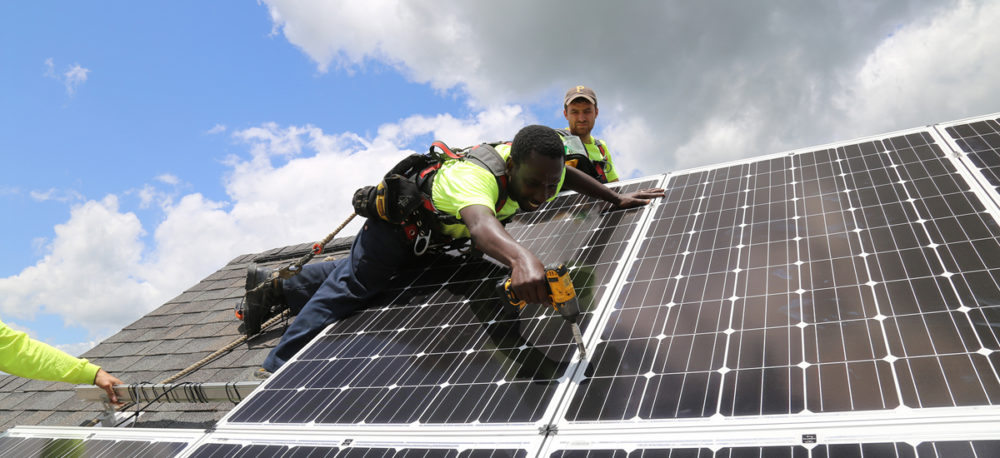The official industry solar results for 2017 have just been released, and as always there’s a lot to process. Here are three takeaways that jump out.
1. Annual solar installations took a hit.
The amount of solar installed during 2017 was appreciably below what 2016 racked up, say GTM Research and the Solar Energy Industries Association (SEIA) in their annual report.
We were coming off an incredibly strong 2016 performance, driven in part by a key tax policy deadline, so 2017 was going to be a year for the industry to catch its breath anyway. President Trump toying with the idea of solar tariffs, though, unsettled companies and customers. And the late 2017 tax law undermined, or at least muddied, some of the federal incentives for solar.
So that part of the drop was not unexpected.
But we also saw softening in key residential markets. Massachusetts, for example, is (again) bumping up against state-mandated caps on “net-metered” solar, and having some growing pains in moving to a new approach to customer incentives. In California, GTM and SEIA said, the drop was due to “a wet winter and saturation in the state’s largest solar market”.
2. But solar still soared overall.
But pull the lens back a bit, temporally, and it’s easy to see a lot to celebrate in the 2017 results:
- With 10,618 megawatts of new solar capacity installed during the year, 2017 was second only to 2016.
- Those 10,618 megawatts are enough to meet the electricity needs of more than 2 million typical US homes.
- The 2017 total for new solar capacity was more than 40% above 2015’s, and more than three times what got installed just five years earlier.
- Total installed US solar capacity, at 53,000 megawatts, is now twice what it was at the end of 2015.
The 2017 installation total for the residential sector, down 16% from 2016, still grew in 25 out of the 44 states that GTM/SEIA track, and was 80% higher than in 2014.
And the non-residential sector actually had a great year, with 28% more capacity installed during 2017 than in 2016. That category includes systems for businesses (commercial and industrial), but also community/shared solar, which accounts for 20% of that category. Community solar systems let households or businesses buy into solar by subscribing from a distance. And that’s a great thing as we continue to work to serve households that can’t do solar on the roof (renters, etc.).
3. And… we can do better.
GTM/SEIA are projecting that 2018 installations will be right around the same level as 2017, and that then we’ll start to climb. But their projections—reasoned and well-grounded though they are—aren’t our destiny. “There is no rule that says just because there’s a projection of a flat year or doubling by 2022 that we can’t do better,” says Dan Whitten, SEIA’s vice president of communications.
So how do we bend that curve upward even more quickly?

Credit: Aeon Solar via NREL
GTM’s Austin Perea, the new report’s lead author, points to permitting as one area of real opportunity, pointing out that other countries have much more streamlined processes for residential solar. It’s been clear for years that “soft costs”, the non-hardware piece of solar systems, could be a lot lower than they are.
Stabilizing our national energy policies would help, too. Our president’s obsession with tariffs is now set to make steel and aluminum more expensive, on top of the direct solar tariffs from last month, which hits solar and other renewables, and destabilizes energy markets more broadly.
We also need to get state solar policies aligned with the opportunity that solar represents, for energy, security, and jobs. In Massachusetts, for example, we need to get rid of the caps that are standing in the way of more solar, nail down state incentives, and remove barriers to adoption of solar by a broader swath of our neighborhoods by not discouraging community solar.
And we need to continue to innovate. Lower costs and greater value via innovation will make it that much easier for companies to weather the slings and arrows of federal and state policy swings, and for would-be customers to be able to gauge the solar value proposition.
Bright future, now
However it happens, solar’s future is bright, and solar will grow. As SEIA’s Whitten says, “It’s not a question of if, but when.”
Given the role solar can play, and is playing, in moving us toward clean energy, we just need that future to be as bright as possible, and as soon as possible.




